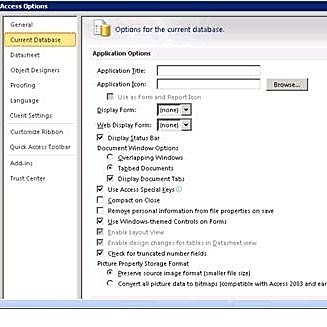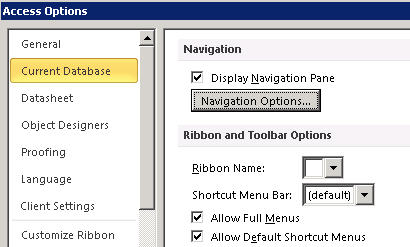Set user options for current database from a centralized location
To customize several user settings such as, how object windows display, to enable keyboard shortcuts, and to enable automatic correction options for a Microsoft Access 2010 database that is currently open, use the options in the Current Database category. You can set these options from Access 2010 in client mode.
What are client mode and Web mode?
Client mode Client mode is the mode that you use to create standard Access applications. In this mode, all the standard features (controls, data types, macro actions, properties, and so on) are available for use. When you use Access 2010 to open a database application that was created by using an earlier version of Access, Access 2010 opens in client mode.
Web mode Web mode is the mode that you use to create Access Web applications. In this mode, the design environments for forms, tables, queries, and so on are configured so that you can only add features that are Web-compatible.
Note: To make these changes, your database must be open and some of the setting changes are applied only after you close and reopen the database.
What do you want to do?
Customize options for your current database
Some features that you can quickly customize for your current application or database include, how the application name and logo are displayed, how object windows are displayed, and how files are managed.
-
From a database that is currently open, Click the File tab.
-
Click Options, and select settings from Application Options.

| Setting | Description |
| Application Title | Specify a custom name to be displayed in the Windows title bar of your current database. |
| Application Icon | Select an icon for your current database. Either type the name of the image file or, click Browse to locate an image file. The selected icon will appear in the Windows title bar. |
| Use as Form and Report Icon | When selected, the application icon will display in all form and report tabs of the current database. If the document tabs are not enabled, the icon does not be displayed. |
| Display Form | Specify a form that appears when your current database opens. Keep the default setting (none) if you don't want any form to appear when the database is opened. |
| Web Display form | When selected, will let users set, change, or remove forms that appear on the Web. |
| Display Status Bar | When selected, will display a status bar at the bottom of the Access workspace. |
-
If an option that you changed requires you to close and reopen the database, and click the File tab.
-
Click Close Database.
-
To reopen, click Open and select the database.
Select settings for how object windows appear
In previous versions of Access, all objects opened in their own windows and working with multiple windows meant constantly resizing them. Access 2007 included the option of displaying all the open objects in a series of tabs along the top of the object window. With this option, it is easier to switch between the open objects by clicking the required tab. You have the option to set the following display options from the The Document Window Options area in the Current Database category.
| Setting | Description |
| Overlapping Windows | When selected, multiple open objects are displayed overlapping one over the other. |
| Tabbed Documents | When selected, only one object is visible at a time even if multiple objects are open. You can use the Tabbed Document setting without having the document tabs displayed. This would be helpful when users need to work with one object at a time. If you clear this option, be sure to include another navigation option to allow users to switch to different objects. |
| Display Document Tabs | If you select the Tabbed Documents option, you can also select this option to display tabs for all open objects. |
| Use Windows-themed Controls on Forms | When selected, uses your Windows theme on the controls of forms and reports in the current database. |
| Enable Layout View | When selected, shows the Layout View button on the Access status bar and in the shortcut menus that appear when you right-click an object tab. If you clear this option, the user will not be able to open the forms and reports in the Layout view. Note: After you clear this option, the Layout View will not be available as an option from the Views group or any of the shortcut menus. |
| Enable design changes for tables in Datasheet view | When selected, lets you change the design of tables from the Datasheet view. |
| Check for truncated number fields | When selected, Access displays numbers as "#####" when a column is too narrow to display the entire value. If the option is not selected, the values visible in a column are truncated based on what can fit in the column. |
| Picture Property Storage Format | When selected, Access stores images in their original format. Select this option to reduce database size. |
| Convert all picture data into bitmaps (compatible with Access 2003 and earlier) | When selected, Access creates a copy of the original image file in either the Windows Bitmap or Device Independent Bitmap formats. Select this option to view images in databases created in Office Access 2003 and earlier. |
Enable the use of Access keyboard shortcuts
When the Use Access Special Keys option is selected, users are able to use the following keyboard shortcuts in the current database:
| Keys | Result |
| F11 | Shows and hides Navigation Pane. |
| CTRL+G | Shows the Immediate window in the Visual Basic Editor. |
| ALT+F11 | Starts the Visual Basic Editor. |
| CTRL+BREAK | When working with an Access project, pressing this key combination stops Access from retrieving records from the server. |
Set file management options for your current database
These file management settings will only apply to the database that is open when you select the options.
| Setting | Description |
| Compact on Close | When selected, the database is automatically compacted when you close it. |
| Remove personal information from file properties on save | When selected, automatically removes personal information from the file properties when you save the file. |
Select navigation options for your current database
You can customize the navigation for your current application from these options:

| Setting | Description |
| Display Navigation Pane | If you clear this option, the Navigation Pane will not be displayed when the current database is opened. |
| Navigation Options | When selected, you can change the categories and groups that appear in the Navigation Pane and set options for how objects open in the current database. |
| Ribbon Name | Select a name for a custom Ribbon group. |
| Shortcut Menu Bar | Set or change the default menu bar for shortcut menus. |
| Allow Full Menus | If you clear this check box, only the Home tab will be visible on the Ribbon. In addition, the Save and Save As commands are not available when you click the File tab. |
| Allow Default Shortcut Menus | Turns on or off the shortcut (pop-up) menus that appear when you right-click a database object in the Navigation Pane or a control on a form or report. You must close and reopen the current database for the specified option to take effect. |
Set options to track and correct field names in your current database
The Name AutoCorrect option asks Access to track and correct field name reference in forms, reports, and queries. You can set the following options for your current database:
| Setting | Description |
| Track name AutoCorrect info | When selected, Access stores the information needed to correct naming errors. Allows you to use the Object Dependencies feature. However, Access does not repair errors until you select the Perform name AutoCorrect option. |
| Perform name AutoCorrect | When selected, Access repairs naming errors as they occur. If you select the Track name AutoCorrect info option and leave this option blank, Access stores any error data until you select this option. |
| Log name AutoCorrect changes | Access logs the changes it makes to a database when it repairs name errors. Access saves the data in a table named AutoCorrect.log. |
Set filter options for your current database
You can sort the information displayed in a form by defining a filter using Filter by Form definition and select display values for the Filter by Form window for a current database.
The options in this section control several features such as, the size of the value lists that appear for a given field in the Filter By Form window. You can select options for whether a user can display values for indexed or non-indexed fields and for a linked table in an external file. You can also select options for whether value lists appear in the controls in a form when the Filter by Form is used.
| Setting | Description |
| Local indexed fields | When selected, displays values from local indexed fields in the value lists that appear in the Filter by Form window. |
| Local nonindexed fields | Includes values from local nonindexed fields in the value lists that appear in the Filter by Form window. |
| ODBC fields | Includes values from tables to which you link by using an Open Database Connectivity connection. |
| Don't display lists where more than this number of records read | Enter the maximum number of records that you want Access to read while it builds the value list for Filter by Form operations. A value list will not appear if the number of records required to complete a list exceeds the number you specify. All values lists will contain only unique values, even if their fields are not indexed. The default is 1000. |


No comments:
Post a Comment